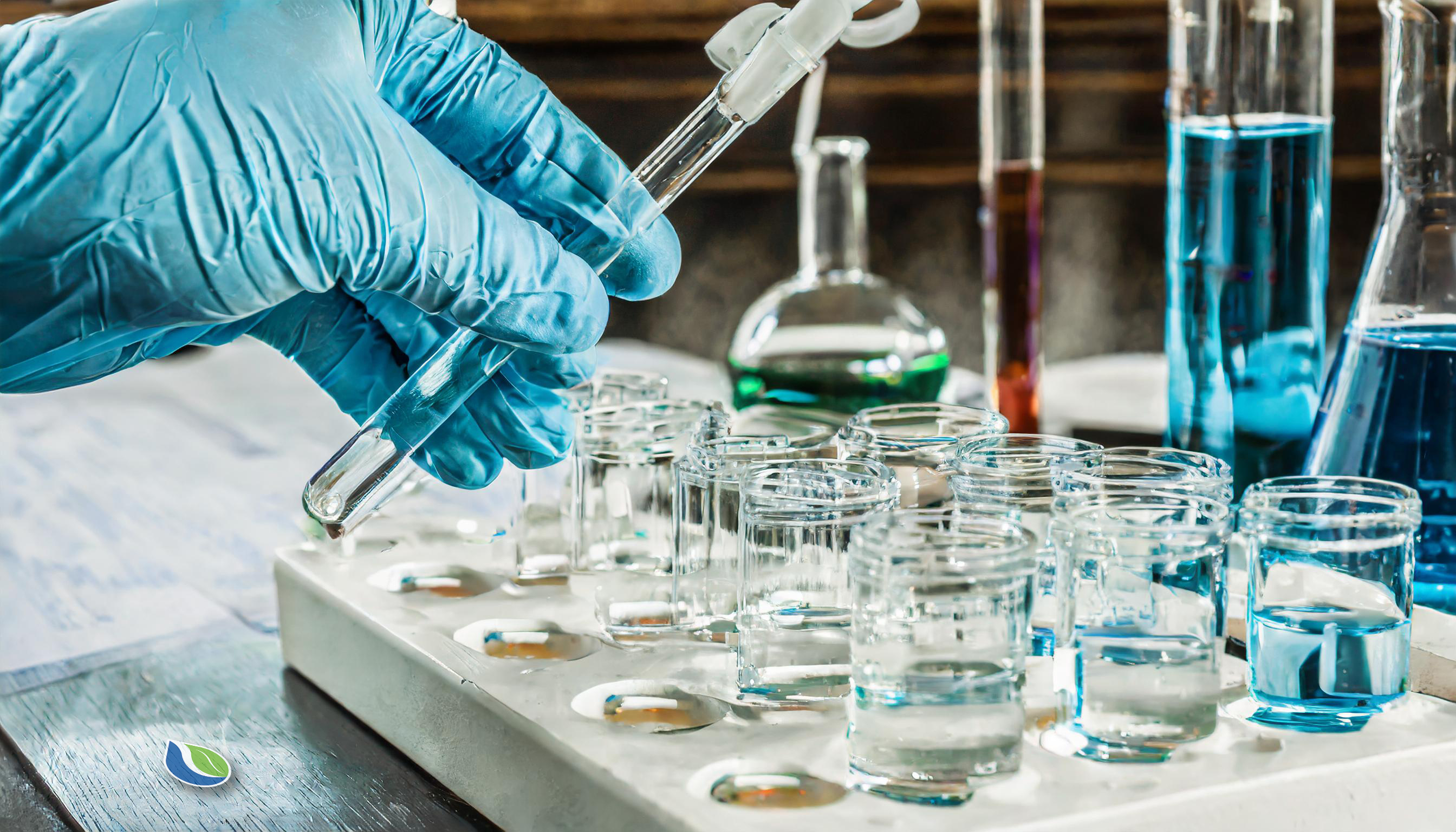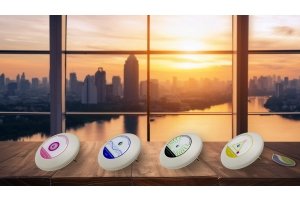
In our daily lives, water is often taken for granted. We use it for hydration, cleaning and cooking without thinking too much about it. However, the quality of the water we consume can have a significant impact on our health and well-being. Meditech Europe offers a range of products that can improve the quality of water, such as water ionizers, ozone generators, hydrogen generators, reverse osmosis systems and water distillation equipment. In this extensive blog we will delve deeper into the chemical composition of water, the influence of different treatments on the pH and ORP values, and the benefits of ionized, ozone-rich, hydrogen-rich, osmosis water and distilled water for our body.
The Chemical Structure of Pure Water
Pure water, chemically represented as H2O, consists of two hydrogen atoms (H) and one oxygen atom (O). These atoms are connected by covalent bonds. In a covalent bond, atoms share electrons to achieve a stable electron configuration. In the case of water, each hydrogen atom shares one electron with the oxygen atom, making the oxygen atom share a total of two additional electrons - one from each hydrogen atom. This results in a molecule where the oxygen atom has a slightly negative charge (because of the extra electrons) and each hydrogen atom has a slightly positive charge. This distribution of charge leads to the formation of a dipole moment, which causes water molecules to attract each other through hydrogen bonds. These hydrogen bonds are responsible for many of water's unique properties, such as its high boiling point, high surface tension, and ability to dissolve many substances.
The Chemical Structure of Tap Water
Tap water, also known as tap water, is water supplied through water pipes for domestic and commercial use. The chemical composition of tap water can vary widely depending on location, the source of the water (such as groundwater, surface water, or a combination thereof), and the treatment the water has undergone before reaching the consumer. Despite this variation, there are some common components that may be present in tap water:
- Water (H₂O): Naturally, the primary component of tap water is water itself, a compound consisting of two hydrogen atoms and one oxygen atom.
- Minerals and Salts: Tap water often contains dissolved minerals and salts, including calcium (Ca²⁺), magnesium (Mg²⁺), sodium (Na⁺), potassium (K⁺), chloride (Cl⁻), bicarbonate (HCO₃⁻), and sulphates (SO₄²⁻). The amount and types of minerals depend on the local geology and water source.
- Trace elements: Depending on the source and treatment of the water, there may also be trace elements such as iron (Fe), manganese (Mn), copper (Cu), zinc (Zn), lead (Pb), and arsenic (As) in tap water prevent. Drinking water quality standards ensure that these elements remain within safe limits.
- Chlorine and Chlorine Compounds: Many water companies use chlorine or chlorine compounds such as chlorine dioxide (ClO₂) or hypochlorite (OCl⁻) to disinfect water and prevent bacterial contamination. These may be present in small quantities in tap water.
- Fluoride: In some regions, fluoride is added to tap water to help prevent tooth decay. The concentration of fluoride is carefully controlled to remain within recommended safe limits.
- Organic Substances: Natural organic substances derived from plant remains and micro-organisms may be present in small quantities in tap water. In addition, there may be traces of synthetic organic chemicals from industrial pollution or agricultural activities.
- Microorganisms: Although water purification processes aim to remove harmful bacteria, viruses and parasites, microorganisms (pollution) may still be present in the water.
The exact chemical composition of tap water depends on many factors and varies by location. Water quality reports, often provided by local water utilities, can provide specific information about the chemical composition of tap water in a particular area.
What is the ORP value of Water?
The ORP value, or Oxidation-Reduction Potential, of water is a measure of the extent to which the water is able to oxidize or reduce substances. This is expressed in millivolts (mV). The ORP value can vary depending on the presence of contaminants, the type and amount of dissolved solids, and other factors such as the temperature of the water.
In general terms, pure water can have an ORP value ranging from approximately -200 to +800 mV. Drinking water typically has a positive ORP value, indicating an oxidative state. This may vary depending on the treatment the water has undergone.
For example, water treated with chlorine often has a higher ORP value, indicating a stronger oxidative capacity, which is beneficial for killing bacteria and other pathogens.
Negative ORP values indicate a reductive or antioxidative state, which may indicate the presence of certain minerals or other substances that act as antioxidants. Some people believe that water with a negative ORP value may provide health benefits by reducing oxidative stress in the body, although this topic is still subject to research and debate.
It is important to note that the ideal ORP value for drinking water may vary depending on local standards and guidelines. Therefore, it is advisable to consult local health authority guidelines or water quality standards for specific information on the desired ORP value of drinking water in your area.
What is the PH Value of Water?
The pH of water of water is a measure of its acidity or alkalinity, ranging from 0 to 14. A pH of 7 is considered neutral, values lower than 7 indicate acidic water, and values higher than 7 indicate basic (alkaline) water. The pH value of water is crucial for both the environment and human health. For the human body, maintaining a stable pH level is essential; For example, our blood has a narrow pH range of approximately 7.35 to 7.45. Drinking water with an extremely low or high pH can cause health problems such as skin and eye irritation, stomach problems, and in severe cases it can affect internal organs. In addition, water with an abnormal pH can reduce the effectiveness of disinfectants, increasing the chance of bacteria spreading. It is therefore important that water sources have a safe pH level to protect human health and the environment.
The Benefits of Ionizing Water
Ionization of water refers to the process of separating water into acidic and basic components under electrical influence. This process can provide several benefits for both domestic and industrial use. Below we discuss the benefits, the influence on the Oxidation Reduction Potential (ORP) and pH, and the chemical reactions that take place during the ionization process.
Benefits of Water Ionization
- Improved Hydration: Ionic water has smaller water clusters, meaning it can be more easily absorbed by the cells, leading to better hydration.
- Antioxidant Rich Water: Ionized alkaline water contains hydroxide ions (OH-) that act as powerful antioxidants. These antioxidants can neutralize free radicals and thus contribute to reducing oxidative stress in the body.
- Balance the pH: Drinking alkaline ionic water can help restore the pH balance in the body, especially in a diet rich in acidic foods.
Better Taste: Many users report that ionized water has a smoother and more pleasant taste than regular tap water.
Influence on ORP and pH
- ORP (Oxidation Reduction Potential): Ionized alkaline water usually has a negative ORP, meaning it has antioxidant properties. A lower (more negative) ORP value indicates a greater potential to reduce oxidation, which is beneficial to health.
- pH level: The ionization process increases the pH of water, making it alkaline. This not only affects the taste, but also the bioavailability of minerals in the water and can help neutralize acidity in the body.
Chemical Reactions
The process of water ionization can be described by electrolysis, in which water (H2O) is separated into oxygen (O2) and hydrogen (H2) gases under the influence of an electric current. This reaction takes place in a device called a water ionizer, which is equipped with electrodes (an anode and a cathode).
2H2O(l)→2H2(g)+O2(g)2H2O(l)→2H2(g)+O2(g)
During this process:
- A reduction reaction is carried out at the cathode, producing hydrogen gas and releasing hydroxide ions (OH-), resulting in alkaline water.
- An oxidation reaction takes place at the anode, producing oxygen gas and releasing hydrogen ions (H+), resulting in acidic water.
This separation produces alkaline water (with a higher pH and negative ORP) on one side of the device, and acidic water (with a lower pH and positive ORP) on the other side. The specific chemical composition of the ionized water can vary depending on the minerals present in the source water.
Understanding the scientific principles behind water ionization is essential to fully appreciate its potential benefits and applications.
Although some claims about the health benefits of ionized water remain subject to debate, the process offers interesting chemical and physiological effects that merit further study.
The Benefits of Hydrogen in Water
Hydrogen in water, often referred to as hydrogen-rich water, has several supposed health benefits and affects both the Oxidation Reduction Potential (ORP) and pH of water. Below is an explanation of the benefits, followed by the influence on ORP and pH, and a description of the chemical reactions that take place.
Benefits of Hydrogen Rich Water
- Antioxidant properties: Hydrogen is a powerful antioxidant that can neutralize free radicals in the body. Free radicals are unstable molecules that can cause cellular damage, leading to aging and disease. By neutralizing these free radicals, hydrogen-rich water can help slow the aging process and reduce the risk of chronic diseases.
- Anti-inflammatory: Chronic inflammation is linked to many diseases, including heart disease, cancer and autoimmune diseases. Hydrogen has anti-inflammatory properties that can help reduce inflammation in the body.
- Improved Energy: By neutralizing free radicals and reducing oxidative stress, hydrogen-rich water can help improve energy levels and increase overall vitality.
Influence on ORP and pH
- Oxidation Reduction Potential (ORP): Hydrogen-rich water has a negative ORP, meaning it has antioxidant properties and can act as a reducing agent. A lower (more negative) ORP value indicates a higher antioxidant potential, which may be beneficial to health by reducing oxidative stress.
- pH level: Adding hydrogen to water generally has little to no effect on the pH value. Hydrogen gas dissolves in water without forming ions that would change the pH. However, depending on the method used to dissolve hydrogen gas in water, byproducts may be formed that may slightly affect the pH.
Chemical Reactions
When hydrogen gas (H2) is dissolved in water (H2O), no chemical reaction takes place in the sense of forming new compounds. Instead, the hydrogen gas physically dissolves in the water, similar to how oxygen dissolves in water. No direct chemical reactions take place between the hydrogen gas and water molecules to change the composition of water. However, when hydrogen gas is absorbed into the body, it can react with free radicals such as hydroxyl radicals (·OH) and peroxynitrite (ONOO-), forming water (H2O) and other non-harmful molecules:
H2+2\·OH→2H2OH2+2\·OH→2H2O
H2+ONOO−→H2O+NO2−H2+ONOO−→H2O+NO2−
These reactions help neutralize harmful free radicals, which explains the antioxidant benefits of hydrogen-rich water. It is important to note that the effectiveness and safety of consuming hydrogen-rich water are still under research, and more studies are needed to fully understand and confirm the benefits.
The Benefits of Ozone in Water
Ozone (O3) is increasingly used for water treatment due to its strong oxidation capacity. It provides several water treatment benefits, including disinfection, odor and color removal, and the breakdown of organic matter. Below we discuss the benefits of using ozone in water, and its influence on the oxidation-reduction potential (ORP) and pH value, including the chemical reactions that take place.
Benefits of Ozone in Water
- Disinfection: Ozone is very effective in killing bacteria, viruses and other microorganisms through the oxidation of their cell walls, without the formation of harmful by-products such as with chlorine treatments. This makes it an environmentally friendly choice.
- Odor and Color Removal: Ozone can remove unwanted odors and colors from water. It breaks down the molecules responsible for these odors and colors, resulting in clearer and fresher-smelling water.
- Decomposition of Organic Compounds: Ozone can break down complex organic compounds, such as pesticides and pharmaceutical substances, into less harmful components. This reduces the overall toxicity of the water.
Influence on ORP and pH
- ORP (Oxidation-Reduction Potential): The addition of ozone to water increases the ORP value, which is a measure of the water's oxidation potential. A higher ORP value indicates a stronger disinfectant capacity. This is because ozone is a strong oxidizer, which can strip electrons from pollutants and microorganisms, inactivating or breaking them down.
- pH level: The use of ozone generally has little direct effect on the pH value of water. However, the chemical reactions that take place during ozonation can lead to the formation of oxygen acid (H2O3) and hydrogen peroxide (H2O2), which can slightly influence the pH value. In general, pH changes remain within acceptable limits for most applications.
Chemical Reactions
The main chemical reaction of ozone in water is the oxidation of pollutants. The reaction can be schematized as follows:
Direct Oxidation: Ozone (O3) reacts directly with pollutants by electron transfer, reducing the ozone to oxygen (O2) and oxidizing the pollutant.
O3+Pollutant→O2+Oxidized pollutantO3+Pollutant→O2+Oxidized pollutant
Indirect Oxidation: Ozone can also split water molecules (H2O) to form hydroxyl radicals (OH), which are highly reactive oxidants. These radicals can then oxidize organic substances and micro-organisms.
O3+H2O→2·OH+O2O3+H2O→2·OH+O2
These reactions increase the ORP value of the water, indicating a strong oxidative environment conducive to disinfection and degradation of contaminants. The formation of oxygen as a byproduct of these reactions contributes to the improvement of water quality without significantly affecting the pH.
The Benefits of Osmosis Water
Osmosis water, often referred to as reverse osmosis water, has several advantages over regular tap water. This type of water is produced by a process in which pressurized water is passed through a semipermeable membrane to remove contaminants such as salts, bacteria, viruses, pesticides, and chemical contaminants. Here are some benefits:
Benefits of Osmosis Water
- Removal of contaminants: Reverse osmosis can remove up to 99% of dissolved solids (TDS), heavy metals, and chemical contaminants from water. This results in purer water, which is better for consumption and less harmful to the body.
- Improved taste: By removing contaminants and minerals, osmosis water can have a cleaner and fresher taste compared to tap water.
- No limescale: Because most minerals are removed, osmosis water causes less limescale in appliances such as kettles and coffee makers, which can extend the life of these appliances.
- Long-term cost savings: Although the initial investment in a reverse osmosis system can be significant, it can save costs in the long term by reducing the need for bottled water and extending the life of home appliances.
Influence on ORP and pH
- ORP (Oxidation-Reduction Potential): Osmosis water often has a higher ORP value, meaning it has a greater potential to undergo oxidation. This is sometimes associated with an ability to neutralize harmful organisms and substances in the body, although the health benefits of this are subject to debate.
- pH level: Removing minerals can affect the pH level of the water, making it slightly acidic. This is because the absence of buffering minerals such as calcium and magnesium causes the pH to drop. Some systems add minerals back to the water after filtration to neutralize the pH.
Chemical Reactions
The chemical reactions that take place during the osmosis process are mainly physical processes in which molecules and ions are separated by a semipermeable membrane. No chemical reactions occur in the traditional sense of breaking or forming chemical bonds during the filtration process. The change in ORP and pH is more a result of the removal or addition of certain substances than of chemical reactions. The process changes the composition of the water by selectively removing molecules and ions, not by chemically changing them.
It is important to emphasize that while reverse osmosis offers many benefits, it can also remove essential minerals that the body needs. Therefore, some people choose to re-add minerals to reverse osmosis water or adjust their diet to obtain these minerals in other ways. Most osmosis systems work with filters and membranes that become contaminated over time and need to be replaced. The effectiveness is therefore not stable.
The Benefits of Water Distillation
Water distillation is the process of boiling water until it evaporates and then condensing it back into liquid form, leaving behind many of the impurities and contaminants. This process has several benefits for the quality and purity of the water, and it also affects the Oxidation-Reduction Potential (ORP) and the pH value of the water. Below is an explanation of the benefits of water distillation, followed by the effects on ORP and pH and an overview of the chemical reactions that take place during this process.
Benefits of Water Distillation
- Removal of contaminants: Distillation can effectively remove a wide range of contaminants, such as bacteria, viruses, heavy metals, and chemical contaminants, resulting in pure water (H2O).
- Reduction of limescale formation: By removing minerals such as calcium and magnesium, distillation reduces the risk of limescale build-up in equipment that uses water, such as coffee makers and steam irons.
- Stable in quality: Because no filters are used in the distillation process, the end result is very stable.
- Taste improvement: Removing impurities can improve the taste of the water, making it fresher and purer.
- No need for chemical treatment: Distillation is a purely physical process that does not require any chemical treatment agents to purify water.
Influence on ORP and pH
- ORP (Oxidation-Reduction Potential): Distillation can affect the ORP value of water. ORP is a measure of the ability of a liquid to oxidize or reduce. Pure water tends to have a higher ORP value, which means its oxidation capacity increases. However, without the presence of minerals and other dissolved substances, the water may be less effective at transferring electrons, which can result in variations in the ORP value. This is a good reason to add minerals to the distilled water in a controlled manner. This can be done by using, for example, the Mineral stone.
- pH level:The distillation process can also affect the pH value of water. Distilled water is pure and contains no dissolved substances, resulting in a neutral pH value of 7. When in contact with air for a long time, it can absorb carbon dioxide, which will lower the pH slightly.
Chemical Reactions
- Phase Change: When water (H2O) boils, it changes from a liquid to a gaseous state. This is a physical process, not a chemical reaction.
- Separation of substances: During the condensation phase, dissolved solids and non-evaporable elements are left behind. This process does not change the chemical composition of the water, but separates the water from other substances.
- Absorption of CO2: When distilled water comes into contact with the air, it can absorb carbon dioxide (CO2), resulting in the formation of carbonic acid (H2CO3), a weak acid. This can lower the pH of the water.
CO2(g)+H2O(l)→H2CO3(aq)CO2(g)+H2O(l)→H2CO3(aq)
The influence of distillation on ORP and pH is primarily a result of the removal of solutes and the interaction of the distilled water with the environment after the distillation process. It is important to note that although distilled water is pure, its lack of minerals may mean that it is not ideal for all uses, especially where minerals in water are desired for health reasons or taste.
Which Water is the Healthiest for our Body?
To determine which type of water is healthiest for our body, we must look at each of the listed types of water based on their characteristics, benefits and possible disadvantages. It is important to note that the health benefits of different types of water can vary depending on individual health needs, local water quality and personal preference. Here's an overview:
Ionized Water
Characteristics: This is water that goes through an ionizer to adjust the pH level. The result is often alkaline water.
Benefits: Some believe that drinking alkaline water can help neutralize acid in the body, improve hydration, and other health benefits.
Cons: There is limited scientific evidence supporting the claimed health benefits. Long-term use can also lead to a disruption of the body's natural acid-base balance.
Hydrogen water
Characteristics: Water in which extra hydrogen gas has been dissolved.
Benefits: It is said to have antioxidant properties and can reduce inflammation.
Disadvantages: As with ionized water, concrete scientific evidence for health benefits is limited.
Ozone Water
Features: Water treated with ozone to kill bacteria and other microorganisms.
Benefits: Effective at disinfection and may be safer to drink than water that has not been disinfected.
Disadvantages: Ozone can be harmful when inhaled, but this is only harmful at high concentrations (higher than 100 µg/m³ measured over 8 hours).
Osmosis Water
Features: This water is filtered by reverse osmosis, removing most contaminants.
Advantages: Very pure water, free from most contaminants, including bacteria and chemicals.
Disadvantages: Removing minerals can result in 'dead water', which may not contribute to daily mineral intake. The quality is also not stable due to contamination of membranes and filters.
Distilled water
Characteristics: Water that has been boiled and had its steam condensed back to liquid form, removing almost all contaminants and minerals.
Advantages: Very high and constant purity.
Disadvantages: As with osmosis water, the absence of minerals can be seen as a disadvantage for the nutritional value, but is easily solved by a healthy diet or controlled addition of minerals.
Tap water
Features: Water that comes from the tap has been treated according to local health standards to make it safe for consumption.
Advantages: Readily available, often contains essential minerals, and is usually economically attractive.
Disadvantages: Quality can vary depending on location and sometimes contaminants may still be present.
Conclusion
In general, tap water is considered safe and healthy in many areas, especially if it meets all local health standards and regulations. For those seeking extra purity or who have specific health needs, filtered options may be suitable. The most reliable variant seems to be Distilled Water, especially because the quality is always the same and the purity is very consistent. Adding minerals may be necessary to maintain the nutritional value, but this is not necessary if a healthy diet is followed.
It is important to research local water quality and personal health needs when choosing the type of water to drink. Most people have no idea about the quality of the water they drink all day long.
FAQ
What is ionized water?
Ionized water is water that has gone through a process of ionization, in which the water is split into acidic and basic components. This process can change the pH of the water. Ionized alkaline water is often promoted for its health benefits, including better hydration and antioxidant properties, although scientific evidence for this is limited.
What is hydrogen water?
Hydrogen water is water that contains extra hydrogen molecules. These molecules can act as powerful antioxidants, giving this type of water potential benefits such as reducing inflammation and improving recovery after exercise. However, the scientific evidence is still developing.
What is ozone water?
Ozone water is produced by injecting ozone (O3) into water. This process can kill bacteria, viruses and other microbes, making ozone water effective for disinfection. It is commonly used in food processing, water purification and medical therapies. It is important to note that ozone water must be handled safely to avoid exposure to ozone gas.
What is osmosis water?
Osmosis water, often referred to as reverse osmosis water, is water that has been filtered using reverse osmosis technology. This process removes many of the contaminants, including salts, bacteria, and viruses, resulting in very pure water. It is widely used in household water filter systems and for industrial applications.
What is distilled water?
Distilled water is water that has been boiled into steam and then condensed back into liquid form, removing virtually all minerals and contaminants. The result is exceptionally pure water. Distilled water is used in households, laboratories, in medical equipment, and in certain industrial processes, production of Colloidal products and in the care of certain plants.
What is tap water?
Tap water is water supplied to homes and businesses through the water pipe. The quality and composition of tap water can vary greatly depending on location, but it must meet strict government standards for drinking water quality. This of course varies per country and region. Tap water usually contains various minerals and may also contain small amounts of chlorine or other disinfectants to keep the water safe for consumption. Unfortunately, not all contamination from our tap water is always removed by the water treatment companies. You can measure your tap water at home. A simple PPM measurement says a lot.
Need help and support?
The quality of the water we consume has a significant impact on our health and well-being. By using water treatment systems such as those offered by Meditech Europe, we can improve our water and enjoy the many health benefits that ionized, ozone-rich, hydrogen-rich and distilled water have to offer. For more information and support, customers can contact Meditech Europe via info@meditecheurope.nl and +31527 292 331.




